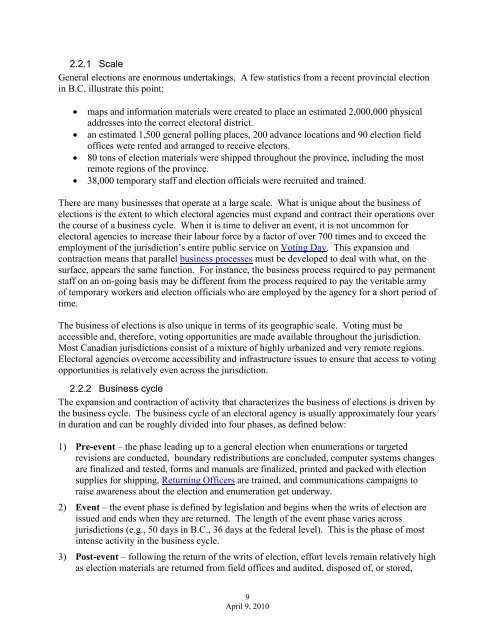Electoral-Management-Reference-Model-v.1.0
Electoral-Management-Reference-Model-v.1.0
Electoral-Management-Reference-Model-v.1.0
Create successful ePaper yourself
Turn your PDF publications into a flip-book with our unique Google optimized e-Paper software.
2.2.1 Scale<br />
General elections are enormous undertakings. A few statistics from a recent provincial election<br />
in B.C. illustrate this point:<br />
• maps and information materials were created to place an estimated 2,000,000 physical<br />
addresses into the correct electoral district.<br />
• an estimated 1,500 general polling places, 200 advance locations and 90 election field<br />
offices were rented and arranged to receive electors.<br />
• 80 tons of election materials were shipped throughout the province, including the most<br />
remote regions of the province.<br />
• 38,000 temporary staff and election officials were recruited and trained.<br />
There are many businesses that operate at a large scale. What is unique about the business of<br />
elections is the extent to which electoral agencies must expand and contract their operations over<br />
the course of a business cycle. When it is time to deliver an event, it is not uncommon for<br />
electoral agencies to increase their labour force by a factor of over 700 times and to exceed the<br />
employment of the jurisdiction’s entire public service on Voting Day. This expansion and<br />
contraction means that parallel business processes must be developed to deal with what, on the<br />
surface, appears the same function. For instance, the business process required to pay permanent<br />
staff on an on-going basis may be different from the process required to pay the veritable army<br />
of temporary workers and election officials who are employed by the agency for a short period of<br />
time.<br />
The business of elections is also unique in terms of its geographic scale. Voting must be<br />
accessible and, therefore, voting opportunities are made available throughout the jurisdiction.<br />
Most Canadian jurisdictions consist of a mixture of highly urbanized and very remote regions.<br />
<strong>Electoral</strong> agencies overcome accessibility and infrastructure issues to ensure that access to voting<br />
opportunities is relatively even across the jurisdiction.<br />
2.2.2 Business cycle<br />
The expansion and contraction of activity that characterizes the business of elections is driven by<br />
the business cycle. The business cycle of an electoral agency is usually approximately four years<br />
in duration and can be roughly divided into four phases, as defined below:<br />
1) Pre-event – the phase leading up to a general election when enumerations or targeted<br />
revisions are conducted, boundary redistributions are concluded, computer systems changes<br />
are finalized and tested, forms and manuals are finalized, printed and packed with election<br />
supplies for shipping, Returning Officers are trained, and communications campaigns to<br />
raise awareness about the election and enumeration get underway.<br />
2) Event – the event phase is defined by legislation and begins when the writs of election are<br />
issued and ends when they are returned. The length of the event phase varies across<br />
jurisdictions (e.g., 50 days in B.C., 36 days at the federal level). This is the phase of most<br />
intense activity in the business cycle.<br />
3) Post-event – following the return of the writs of election, effort levels remain relatively high<br />
as election materials are returned from field offices and audited, disposed of, or stored,<br />
9<br />
April 9, 2010


